A downloadable version [1] of the BBCH Scales, including illustrations, is available from the BBA [2] (Federal Biological Research Centre for Agriculture and Forestry)
Phenological growth stages and BBCH-identification keys of cereals
|
| Code
| Description
|
| Principal growth stage 0: Germination
|
| 00 | Dry seed (caryopsis)
|
| 01 | Beginning of seed imbibition
|
| 03 | Seed imbibition complete
|
| 05 | Radicle emerged from caryopsis
|
| 06 | Radicle elongated, root hairs and/or side roots visible
|
| 07 | Coleoptile emerged from caryopsis
|
| 09 | Emergence: coleoptile penetrates soil surface (cracking stage)
|
| Principal growth stage 1: Leaf development1, 2
|
| 10 | First leaf through coleoptile
|
| 11 | First leaf unfolded
|
| 12 | 2 leaves unfolded
|
| 13 | 3 leaves unfolded
|
| 1 . | Stages continuous till . . .
|
| 19 | 9 or more leaves unfolded
|
| Principal growth stage 2: Tillering3
|
| 20 | No tillers
|
| 21 | Beginning of tillering: first tiller detectable
|
| 22 | 2 tillers detectable
|
| 23 | 3 tillers detectable
|
| 2 . | Stages continuous till . . .
|
| 29 | End of tillering. Maximum no. of tillers detectable
|
| Principal growth stage 3: Stem elongation
|
| 30 | Beginning of stem elongation: pseudostem and tillers erect, first internode begins to elongate, top of inflorescence at least 1 cm above tillering node
|
| 31 | First node at least 1 cm above tillering node
|
| 32 | Node 2 at least 2 cm above node 1
|
| 33 | Node 3 at least 2 cm above node 2
|
| 3 . | Stages continuous till . . .
|
| 37 | Flag leaf just visible, still rolled
|
| 39 | Flag leaf stage: flag leaf fully unrolled, ligule just visible
|
| Principal growth stage 4: Booting
|
| 41 | Early boot stage: flag leaf sheath extending
|
| 43 | Mid boot stage: flag leaf sheath just visibly swollen
|
| 45 | Late boot stage: flag leaf sheath swollen
|
| 47 | Flag leaf sheath opening
|
| 49 | First awns visible (in awned forms only)
|
| Principal growth stage 5: Inflorescence emergence, heading
|
| 51 | Beginning of heading: tip of inflorescence emerged from sheath, first spikelet just visible
|
| 52 | 20% of inflorescence emerged
|
| 53 | 30% of inflorescence emerged
|
| 54 | 40% of inflorescence emerged
|
| 55 | Middle of heading: half of inflorescence emerged
|
| 56 | 60% of inflorescence emerged
|
| 57 | 70% of inflorescence emerged
|
| 58 | 80% of inflorescence emerged
|
| 59 | End of heading: inflorescence fully emerged
|
| Principal growth stage 6: Flowering, anthesis
|
| 61 | Beginning of flowering: first anthers visible
|
| 65 | Full flowering: 50% of anthers mature
|
| 69 | End of flowering: all spikelets have completed flowering but some dehydrated anthers may remain
|
| Principal growth stage 7: Development of fruit
|
| 71 | Watery ripe: first grains have reached half their final size
|
| 73 | Early milk
|
| 75 | Medium milk: grain content milky, grains reached final size,
still green
|
| 77 | Late milk
|
| Principal growth stage 8: Ripening
|
| 83 | Early dough
|
| 85 | Soft dough: grain content soft but dry. Fingernail impression not held
|
| 87 | Hard dough: grain content solid. Fingernail impression held
|
| 89 | Fully ripe: grain hard, difficult to divide with thumbnail
|
| Principal growth stage 9: Senescence
|
| 92 | Over-ripe: grain very hard, cannot be dented by thumbnail
|
| 93 | Grains loosening in day-time
|
| 97 | Plant dead and collapsing
|
| 99 | Harvested product
|
1 A leaf is unfolded when its ligule is visible or the tip of the next leaf is visible
2 Tillering or stem elongation may occur earlier than stage 13; in this case continue
with stages 21
3 If stem elongation begins before the end of tillering continue with stage 30







